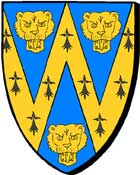Encyclopédie Marikavel-Jean-Claude-EVEN/Encyclopaedia/Enciclopedia/Enzyklopädie/egkuklopaideia

England Bro Saoz |
Whitchurch Mediolanum |

Shropshire / Salopshire *** |
| pajenn bet digoret an 19 Ebrel 2005 | page ouverte le 19 avril 2005 |
* forum du site Marikavel : Academia Celtica |
dernière mise à jour : 10/08/2021 16:48:33 |
![]()
| Définition : Commune d'Angleterre, comté de Shropshire (Salop.). |
|
![]()
|
Extrait de la carte Ordnance Survey : Map of Roman Britain. |
![]()
Histoire : |
![]()
| Étymologie :
A. Mediolanum : * Rivet & Smith, p 415-416 : - Ptolémée, II,3,II : Mediolanion ( = Mediolanium), ville des Ordovices. - Itinéraire d'Antonin, 4694 (Iter II) : MEDIOLANO - Itinéraire d'Antonin, 481,1 et 482,4 : (Iter X) : MEDIOLANO. - Ravenna, 10641 : MEDIOMANO; - Ravenna, 10643-44 : MEDIOLANO SAUDONIO; variantes MEDIOLANA et SAUDONIE. These sources all refer to the same place. Of AI 4694 the editor, Cuntz, remarks that 'Diversum puto ab Mediolano 4811 & 4824', but Richmond in reviewing I. D. Margary's Roman Roads Ii in JRS, XLVIII 1958), 219, observes that 'The difficulty is almost certain to lie in corrupt numbers [in itinerary mileages] rather than two similar names so near.' As for Ravenna's form with -mano, R&C took this literally and assigned a different location to it, but -mano has no meaning and this entry is a simple duplication of 10643, with miscopying, both as often. Ravenna's Mediolano Saudonio is one of the most startling entries in the whole text. The entry is quite plainly an echo from Mediolanum Santonum in Gaul (Santonis > Saintes, Charente-Maritime, France); this figures in the Cosmography at 7722 in the form Mediolano Santinis, where it is, moreover, the only Gallic or Hispanic name to which, in the Cosmography, a tribal adjunct is attached — a distinctive entry whose uniqueness so impressed the compiler when he found it in his map-source that, when he came across another Mediolano in Britain, he added the same tribal adjunct to it. Saud- for Sant- has the common error or u for n, and a mistaken ending. For the intrusive -i- in Ptolemy's form, compare DUNUM1 (Dunium). DERIVATION. This name is very common abroad; Holder II. 497 lists no fewer than forty-two Mediolanum places, the best-known being Milan, said to have been founded in 396 B.C. In GPN 215, Note 7 gives a bibliography. The name is found as far east as Moesia, in the Rhineland, and is most common in Gaul; it seems not to be known in Iberia. See also Vincent 247-48. For Medio-, see the previous name. The second element is probably British *lano- 'plain, level ground', for which see LANUM. The present name therefore probably has a sense ' (place) in the middle of the plain', perhaps preferable to 'central plain' as suggested by Jackson in Britannia, I (1970), 77. However, there are complications. L.-F. Flutre in RIO, ix (1957), 39, draws attention to the fact that 'La situation géographique de nombreux Mediolanum, situés en plein pays montagneux et souvent juchés sur une hauteur' does not agree with the sense 'plain' usually given to the -lanum element; he proposes instead that -lanum is not 'plain' but 'lieu consacré', basing himself on the sense of modem Breton lann; but this seems unacceptable, for this Breton word supposes an original *landa (see VINDOLANDA), and no early form shows a trace of this. Ellis Evans in GPN 215 points out that there may in fact be two homonymous elements subsumed in *lano-, one cognate with Latin plenus (Irish lan 'full', Welsh llawn, Breton leun), the other cognate with planus ' flat '; while this is undoubtedly so, it remains true that the second offers the better sensein toponymy. C.-J. Guyonvarc'h returns to the question in Ogam, XIII, (1961), 142-58, listing all known Mediolanum names and equating these as a category (not precisely in sense) with Medionemeton, holding that they 'ont désigné sans nul doute à l'origine un enclos ou une clairière, au moins un espace libre symbolisant le centre religieux et culturel de la peuplade' (p. 157). The second element in the Mediolanum names is for him *lano-s 'plein' (as Ellis Evans indicates it could be), but 'avec le sens connexe (mais non secondaire) de "parfait, complet"', in an especially religious connotation (for which see further Ogam, XII (1960), 532). For this it is presumably necessary to take Medio- as a noun, 'centre'. This alternative solution is here explained at length because it is obviously a serious possibility, but that put forward earlier, that *lano- in this name is 'plain, level ground' still seems greatly preferable. For one thing, it is very straightforward; for another, the word could well have been used to mean 'small extent of levelled ground' which would take account of those Continental Mediolanum places situated in hilly country, with Medio- then meaning 'central (to the needs of the community)'. IDENTIFICATION. The Roman town of Whitchurch, Salop (SJ 5441); on AI mileages, see pp. 158 and 171, and on Ptolemy's attribution of the place to the Ordovices see p. 121. ***** B. Whitchurch : * Eilert Ekwall : * A.D Mills (1991-2003) : 'white church", i.e probably 'stone-built church', OE hwit + cirice. "Album Monasterium, 1199 (here the name is rendered in Latin), Whytchyrche, 13th cent. Called Westune 'west farmstead' in 1086, DB". ***** C. Snowdon : - A.D Mills (1991-2003) : "(Yr Wydffa) (mountain) Gwyd. Sanawdune 1095. 'Snow hill'. OE snaw + dun. The Welsh name means 'the mound' (Welsh yr + gwyddfa), referring to the mountain's use as a burial place". |
![]()
| Sources :
- Eilert Ekwall : The Concise Oxford Dictionary of English Place-Names. Oxford. 1964-1980. - Ordnance Survey : Map of Roman Britain. - ALF Rivet & Colin Smith : The Place-Names of Roman Britain. Batsford Ltd. London. 1979. - A.D Mills : Oxford Dictionary of British Place Names. Oxford University Press. 1991-2003. |
![]()
|
* forum du site Marikavel : Academia Celtica hast buan, ma mignonig go fast, my little friend |